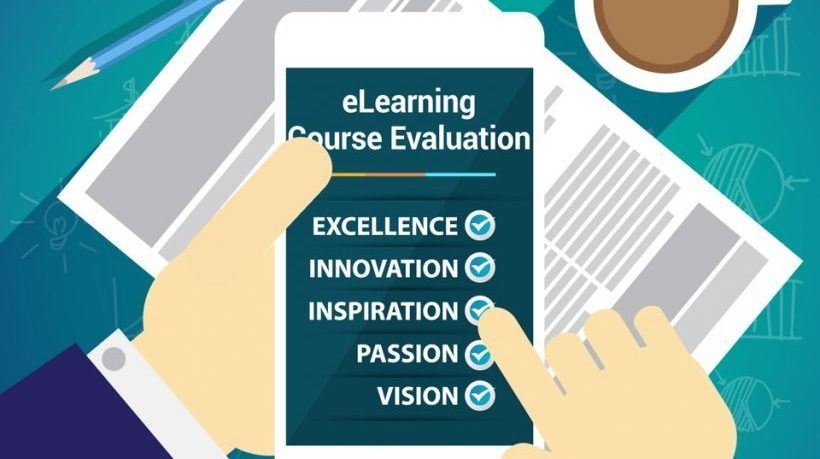15 Aspects To Check In Post-Course Evaluation
Evaluating your eLearning course means receiving feedback, which is probably the most essential tool that eLearning professionals have in order to improve their eLearning deliverables. After all, how else can you know if the decisions you made while designing and developing your eLearning course were to the point? You need feedback from both your clients and your learners, in order to make the necessary revisions and keep improving your eLearning course, so that it gets better every time. There are several ways to do eLearning course evaluation at all stages, that is before your eLearning course’s launch date, during its actualization and after its completion, but post-course evaluation is probably the most challenging. Why? Because it is done by adding a survey at the end of your eLearning course. This survey can be quite lengthy. In order not to overwhelm your learners with thousands of questions, read this article and find out how you can organize your post-course evaluation in such a way that your learners will be happy to give you the feedback you need. All you have to do is write the questions you want to ask and then divide your survey into 15 brief sections, which correspond to the 15 criteria you absolutely must have in mind when conducting your post-course evaluation.
- Accessibility.
The questions that concern the accessibility of your eLearning course will offer you feedback on how easy it is for your learners to access your eLearning course. How accessible was the online material? Could your learners find the information they needed quickly? Was the eLearning navigation effective? Was the eLearning navigation style you have chosen functional? Did all the buttons and links work? Were the footers visible? - Content.
Undoubtedly, your eLearning content is the most important element of your eLearning course, which is why you need the equivalent evaluation questions answered at the beginning of the survey. Via your post-course evaluation you need to know if the subject matter was relevant, if your eLearning content was complete, current, and appropriate and if the examples, stories and scenarios used were relevant and enlightening. - Goals and objectives.
Your eLearning objectives need also to be evaluated early in the survey. How consistent was the eLearning content with your goals and objectives? Were the objectives identified clearly at the beginning of your eLearning course? Did they offer real world benefits? What are the different or extra objectives and goals that your learners may think you should have included in your eLearning course? - Structure.
What about the structure? Was your eLearning content presented in a logical sequence that your audience could easily understand? Were all components consistently organized throughout the eLearning course? Was the table of contents accurate and useful? - Visual design.
Your learners should find the overall eLearning course aesthetically appealing. In the section related to visual design evaluation, a good idea is to ask your audience to briefly comment on how they found your eLearning course in terms of visual design. If you are not interested in a general look and feel evaluation, ask your learners directly if the layout facilitated their learning process. Did they find it attractive? Were colors used effectively? Were the images and graphics chosen effective, relevant, and to the point or did they overshadow the core content? Were the key words highlighted? What about the fonts you used? - Text.
Now it’s time to evaluate the language of your eLearning course. Was the language appropriate for the specific audience? Was spelling and grammar accurate? Were the paragraphs brief enough? Were bullets and numbers used consistently? Think of all the criteria that make eLearning text clear and effective for your audience. - Timing.
How much time did it take your audience to complete your eLearning course? Did they think that the seat time of your eLearning course was too long? How much extra time did they spend on activities related to the eLearning course, by participating, for instance, in online discussions? - eLearning resources.
eLearning resources are additional aids that help your learners gain a better understanding of your eLearning content. In order for you to find out if they were useful, first ask your audience if they indeed used them. Furthermore, did the eLearning course provide them with clear instructions on how to access them? Did the suggested resources provide your learners with the additional information they were looking for? Were they valuable to them? Do they have any suggestions about additional eLearning resources? - Interactivity.
Evaluating the interactivity level after the completion of the eLearning course is essential. You need to know if your audience found interactivity levels satisfactory and, of course, if the interactive elements offered were the most appropriate for the eLearning content. You may also want to ask how these interactive learning activities helped your learners, and how difficult they found the technology they had to use. - Multimedia.
It is not given that all of your learners can easily use multimedia such as the video, audio, or animations, you´ve integrated into your eLearning course. Ask your audience whether the instructions about hardware and software requirements were clear enough or if they believe that something was missing. Also ask them whether they faced any additional technical problems during the eLearning course. Finally, ask them if the amount of multimedia used was adequate. In addition, ask them to rank, from 1 to 5, the multimedia used in terms of quality. - Assessments.
To evaluate the progress of your learners, you have included quizzes and tests in your eLearning course. But were they effective? Ask your audience to evaluate the quizzes included in the eLearning course in terms of relevancy and quality of questions. Also, was there enough variety with respect to different question formats? Was the feedback your learners receive constructive and clear? Is there any way that your quizzes and tests could be improved? - eLearning professional contribution.
At this point, you want to know whether your own contribution to the eLearning course was effective enough to help your learners successfully complete it. Ask your audience to rate your availability at online discussions, and also whether the feedback you gave has been valuable to them. Could your learners contact you directly and, if so, did you respond to their questions on time? All in all, was your contribution helpful? - Social interactions availability.
If you followed a social learning strategy, you will want to know if it actually satisfied your audience. Ask them if they had the opportunity to interact with other learners and maybe what previous experiences they had with online discussions; this way, you will gain valuable feedback on how to handle different levels of your audience´s familiarization with social learning for your next eLearning course. Try to find out whether there was anyone in your audience that felt isolated or alienated during the eLearning course, as well as how important was for your learners to interact with their peers. - eLearning course expectations.
This is particularly important. Were your learners’ personal learning goals, objectives, and expectations met during your eLearning course? Were there any topics that your learners expected, but your eLearning course did not cover? Was the number of learning assignments reasonable and effective? - Overall eLearning experience.
Last but certainly not least, your post-course evaluation should provide you with feedback about learners overall experience with the eLearning course. In the survey’s final questions, ask your learners to rate the eLearning course not only in terms of quality of content, but also in terms of whether the time provided to complete the activities was appropriate. In addition, if your learners were adults, you may be interested in knowing how well the eLearning course fitted their schedule. Finally, ask your learners to identify the most important two or three key concepts they´ve learned, how confident they feel about their knowledge on the subject matter now that the eLearning course has been completed, and maybe to suggest possible ways that your eLearning deliverable could be improved; you never know where an interesting idea may come from.
The above list may seem overwhelming if you are doing a post-course evaluation for the first time, but as you become more familiar with the evaluation process, you will find that it will be easier for you to proceed with it.
If you are looking for a more detailed guide concerning your eLearning course evaluation, read the article eLearning Course Evaluation: The Ultimate Guide For eLearning Professionals. In this article I share why eLearning course evaluation is important, when to do it and, most importantly, how.








